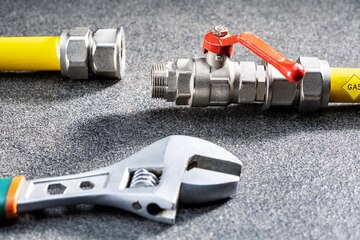Essential Tools and Equipment Used in Gas Pipeline Installation
Gas pipeline installation demands precision and safety, requiring specialized tools to ensure a secure, efficient setup. Let's explore the essential equipment professionals use for a safe and reliable installation.
11/16/20243 min read


1. Pipe Cutters
Purpose: Used for cutting gas pipes to the required length.
Types:
Manual Pipe Cutters: Ideal for smaller pipes.
Rotary Pipe Cutters: Provide a clean, precise cut for larger diameters.
Benefits: Ensures a smooth, straight cut, which is essential for leak-proof connections.
2. Pipe Benders
Purpose: Used to bend gas pipes without causing kinks or cracks.
Types:
Handheld Pipe Benders: Suitable for smaller pipes.
Hydraulic Pipe Benders: Used for larger or more rigid pipes.
Benefits: Allows installers to navigate pipes through tight spaces and around obstacles.
3. Pipe Wrenches
Purpose: Essential for tightening and loosening pipe fittings and connections.
Features:
Adjustable Jaws: Can grip pipes of various sizes.
Heavy-Duty Build: Designed to provide strong leverage without damaging the pipe.
Benefits: Provides a secure grip, reducing the risk of leaks.
4. Threading Machine
Purpose: Creates threads on the ends of pipes, allowing them to be screwed into fittings and connectors.
Features:
Electric or Manual: Options available depending on the scale of the job.
Adjustable Die Heads: For threading pipes of different diameters.
Benefits: Ensures a tight, leak-proof seal between pipes and fittings.
5. Pipe Fitting Tools
Purpose: Used to fit and join pipes together securely.
Includes:
Flaring Tools: For creating flared pipe ends.
Crimping Tools: Used for compression fittings.
Deburring Tools: Smooth out the edges of cut pipes.
Benefits: Ensures a secure connection, reducing the risk of leaks.
6. Gas Leak Detectors
Purpose: Detects the presence of gas leaks during and after installation.
Types:
Electronic Gas Leak Detectors: Provides immediate, accurate readings.
Handheld Gas Sniffers: Portable devices for on-site inspections.
Benefits: Enhances safety by identifying potential leaks before they become hazardous.
7. Pressure Testing Equipment
Purpose: Used to test the integrity of the gas pipeline before it's put into service.
Types:
Pressure Gauges: Monitor the pressure levels within the pipeline.
Hydrostatic Test Pumps: Used for testing the pressure capacity of the pipes.
Benefits: Ensures the pipeline can handle operational pressures without leaking.
8. Torque Wrenches
Purpose: Ensures that bolts and fittings are tightened to the manufacturer's specifications.
Features:
Adjustable Torque Settings: Provides precise control over the amount of force applied.
Benefits: Prevents over-tightening, which can damage fittings and cause leaks.
9. Pipe Locators
Purpose: Helps identify the location of existing underground gas pipelines to avoid damaging them during installation.
Features:
Electromagnetic Detection: Pinpoints the location of metallic pipelines.
Benefits: Prevents accidental damage to existing utilities, enhancing safety and efficiency.
10. Personal Protective Equipment (PPE)
Includes:
Safety Gloves: Protects hands from sharp edges and hot surfaces.
Safety Goggles: Shields eyes from debris during cutting and threading.
Flame-Resistant Clothing: Reduces the risk of injury in case of a gas-related fire.
Benefits: Ensures the safety of installers throughout the installation process.
11. Welding Machines and Soldering Equipment
Purpose: For joining metal pipes securely.
Types:
Arc Welders: Ideal for heavy-duty pipelines.
Soldering Tools: For copper and smaller pipelines.
Benefits: Provides strong, leak-proof joints essential for gas lines.
12. Pipe Clamps and Supports
Purpose: Holds pipes in place during installation and testing.
Features:
Adjustable Sizes: Can accommodate various pipe diameters.
Benefits: Ensures stability and reduces stress on pipeline connections.
Conclusion
Gas pipeline installation is a specialized field that requires precision, expertise, and the right set of tools and equipment. From cutting and bending pipes to testing for leaks, each step of the process is critical to ensure the safety and efficiency of the gas supply. By understanding the tools used, homeowners can gain a better appreciation for the professionalism involved in setting up a gas pipeline system.
Whether you’re planning a new installation or considering an upgrade, it's essential to rely on experts who have the right tools and experience. If you’re looking for a reliable gas pipeline installation service, get in touch with our team today for a safe and efficient solution!
Contact US Today:
Email: info@vaultgaspipeline.site
Phone:
+91 8522 09 2525
+91 95155 92020


Quick Links:
Services
Our Process
Why Choose us
Contact us
Our Services:
Gas Pipeline Installation
Gas Pipeline Maintenance
